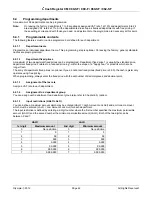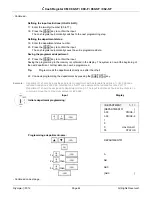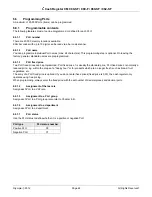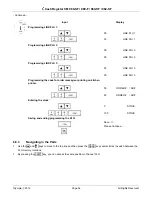
Cash Register CM 980-SF / 980-F / 960-SF / 962-SF
Olympia 2012
Page 49
All Rights Reserved!
6.6.1.8 Input
restrictions (HALO LALO)
You can define a maximum amount which may be entered (HALO = High Amount Lock Out) and a minimum amount
which must be entered (LALO = Low Amount Lock Out) for each PLU.
The input restriction is defined by entering a 2-digit number where the first number specifies the maximum permissible
amount (HALO) and the second number the minimum permissible amount (LALO). Both of the two digits can be
between 0 and 7.
HALO
LALO
1st digit
Maximum amount
2nd digit
Minimum amount
0
No restriction
0
No restriction
1 9
1 9
2 99
2 99
3 999
3 999
4 9.999
4 9.999
5 99.999
5 99.999
6 999.999
6 999.999
7 9.999.999
7 9.999.999
6.6.1.9 LINK
PLUs
LINK PLUs are linked to a "normal" PLU. When the "normal" PLU is then registered, the LINK PLU is automatically
registered too. LINK PLUs are often used in the sale of drinks in deposit bottles, for example. The deposit for the bottle is
then the LINK PLU. A maximum of 3 LINK PLUs can be programmed for each PLU.
Note:
The LINK PLU must be set-up before it is linked during the course of programming a PLU (see Chapter 6.7).
6.6.1.10
2-digit identity number for order messages and printout on the kitchen printer
(a) The first digit in the 2-digit number defines the order message (Order #) to which the PLU should belong.
(b) The second digit in the 2-digit number defines the type of output on the kitchen printer for the PLU (KP #).
Note:
If no order message or kitchen printer should be assigned, a "0" must be programmed for each respective
digit.
(a) Order message / Order number (Order #)
The order messages/numbers only work when the cash register is operating in its gastronomy version. They ensure that
PLUs with the same order numbers (Order #) are printed on the same receipt. The receipts with different order numbers
are printed in succession. This means that meals and drinks ordered and other items sold can be listed clearly (also refer
to Chapter 6.30).
A
maximum of 9 order messages
can be set-up. The order numbers are 1, 2, 3, 4, 5, 6, 7, 8 and 9.
Note:
If no order messages should be assigned (no printout of an order message), a "0" must be programmed as the
first digit of the 2-digit code.
Note:
The order messages can be reprogrammed manually (see Chapter 6.30).
Note:
If the cash register is operated in its retail version (see Chapter 6.35), programme a 0 at this point. The order
function then ceases to be available.
(b) Printout on the kitchen printer (KP #)
Orders can be sent to the kitchen directly and printed by means of an external kitchen printer (also refer to Chapter 6.31).
Note:
A kitchen printer must be activated via system option 9 (status code 2) so that printing on a kitchen printer
works.
Note:
If no kitchen printer should be assigned (no printout of a kitchen receipt), a "0" must be programmed as the
second digit of the 2-digit number.
There are
eight different variations of kitchen receipts
which can combine the printout of order messages and single
messages in the following ways:






























